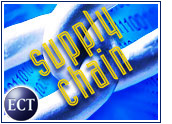
Apparently, some old fuddy-duddies knew a thing or two about the New Economy after all.
Among the companies that managed to squeeze the most money out of the Web in the past year were large, old-line firms with billions in annual revenues. They may not register high on the pop culture radar, but industrial and transportation stalwarts like Burlington Northern Santa Fe (NYSE: BNI), Yellow Freight System (Nasdaq: YELL), and Dow Chemical (NYSE: DOW) have steadily transformed their Internet-based operations into efficient hubs to serve customers and boost the bottom line.
Analysts and company officials told the E-Commerce Times that while struggling, consumer-targeted Net start-ups were hogging the media attention, these long-established industrial companies were working to learn how to use the Internet effectively.
“While other smaller Internet companies were getting in the headlines, itwas the thousand-pound gorillas that took advantage of the Web as a way to reducecosts and increase revenues,” said Lauren Jones Shu, research director for GartnerG2.
B2B Benefits
Andrew Bartels, research leader for e-business at Giga Information Group, said these larger companies have proven themselves adept at handling vast amounts of data on business-to-business (B2B) transactions, using the Web to reduce errors in order-taking, track shipments more easily and speed the handling of billing disputes.
“Much of it is B2B stuff, and it’s become the invisible tip of the icebergin e-commerce,” Bartels said.
Reacting quickly to customer inquiries has been a major factor in the success of these unheralded e-commerce players, said Lisa Williams, director of B2B commerce and enterpriseapplications research at YankeeGroup.
“I think what we’re seeing is that the Internet is particularly suited to companies whose main business is distribution, where a big part of doing business is simply answering acustomer’s questions on ‘Do you have it?’ ‘How much?’ and ‘I’ve ordered it, now where is it?’ ” Williams said.
On the Railroad
Fort Worth, Texas-based Burlington Northern Santa Fe, is, in essence, in the business of answering those inquiries — and making sure it has the right answers. The firm operates one of the largest railroad networks in North America, covering 33,500 miles across 28 states and two Canadian provinces.
Don Harrison, the company’s general director of e-business and marketing systems, said the firm began a program three years ago to “seriously enhance” its online offerings,beefing up its Web-based self-services for order placements, billing andshipment tracking.
The 20,000 registered users on its customer site — about 50 percent of the company’s total customers — are able to get real-time tracking showing where their shipments are at a given time. The system pinpoints every step of the cargo’s journey, including those involving trucks, planes, ships or other railroads.
Billing processes have also been greatly streamlined, with Harrison saying that “the 30 to 60 days it once took to process a billing dispute is now down to two days.”
The effect on revenues has been significant. Between July 2000 and June 2001, Burlington Northern’s online revenues exceeded US$5.57 billion, accounting for morethan half of the company’s overall revenues of $9.29 billion.
Greenlight for MyYellow
Another transportation services provider making optimum use of the Web is Yellow Freight System, where online revenues totaled $1.6 billion out of thecompany’s overall revenue of $2.6 billion in a one-year time frame.
Yellow Freight, the largest subsidiary of Overland Park, Kansas-based Yellow Corp., operates about 400 truck and air terminals in the United States, Canada, Mexico, andPuerto Rico. The company has seen a dramatic rise in the proportion of its total 300,000 customers who are using MyYellow.com to arrange pickups, track shipments and pay bills.
“Right now we’ve got 60,000 registered users on the site,” said Roger Dick, the company’s manager of corporate communications. “Three years ago, that number was zero.”
Yellow’s first Web site was put up in 1995, but it served as no more than a marketing brochure.
“Three-and-a-half to four years ago, we made a conscious decision to upgrade the site as a sales tool to drive business to our services,” Dick said.
Chemical Reaction
Other established companies that sell and distribute large quantities of industrial products on a daily basis do not need to be sold on the financial benefits of a Webpresence.
Dow Chemical, a global science and technology company that makes and markets chemical, plastic and agricultural products, has a three-pronged approach to e-commerce.
Customers of the Midland, Michigan-based firm use its main site, Dow.com, to place orders. The company has a separate “extranet” where registered customers can access their account information and hold online meetings with Dow personnel.
Dow is also involved in online B2B marketplaces, where companies in its industry buy and sell products and services.
Self-Service Emphasis
By bringing all of its sales channels under one roof, company officials say Dow is able to service customers more accurately, and at less cost than phone and other methods.
“Self-service is something we’re striving for,” said Mack Murrell, the company’s global director of customer interface. “We feel if we can do it well for the customers, that will be their preference.”
The main Dow site currently has about 7,000 registered users, and a steadily rising number of overall customers are opting for self-service. Murrell said the companyis seeing a 10 percent month-to-month increase in usage of its Web services and expects registered customers to triple over current numbers in the next year.
From July 2000 through June 2001, Dow’s online revenues accounted for justover $1 billion of its total $29.4 billion in revenues, but officials expect thatproportion will rise as more customers go online.
More to Follow
With the recession and post-September 11th factors affecting all business sectors, Gartner’s Shu expects many more companies to follow the lead of these businesses.
Particularly in the current economy, businesses unable to increase revenues must cut coststo stay profitable, and the Web has proven itself a big part of the equation.
“We’ve moved beyond the early adapters,” Shu said. “Now, mainstream companies are understanding that e-commerce is not just an alternative — it’s an imperative.”













































Social Media
See all Social Media